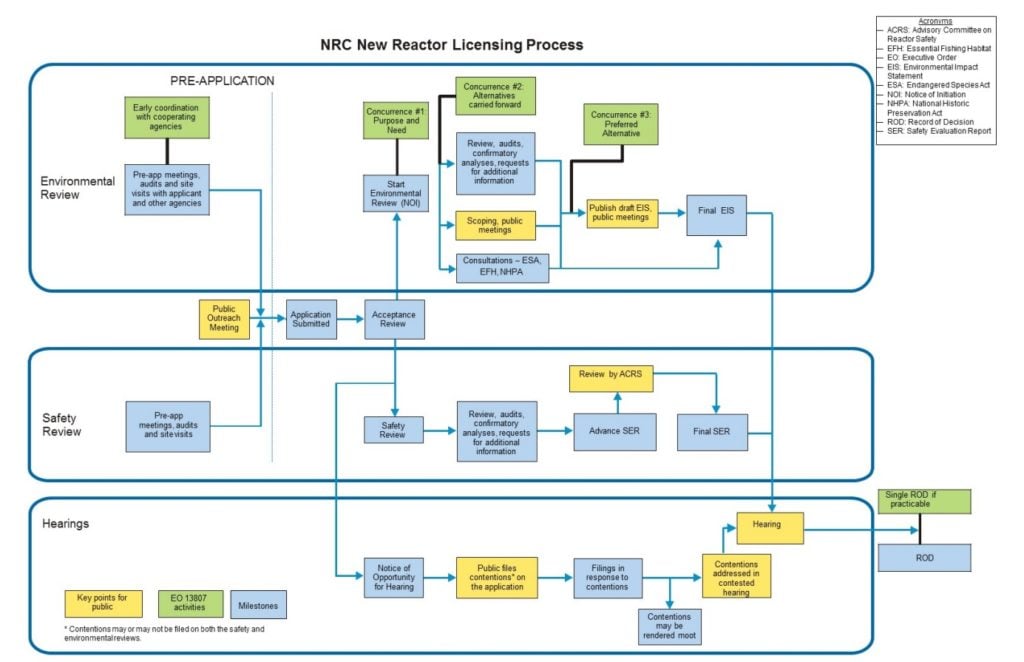Insight
February 25, 2020
Opportunities for NEPA Reform at the NRC
EXECUTIVE SUMMARY
- The current environmental review process at the Nuclear Regulatory Commission (NRC) is long and costly, deterring investment in new nuclear plants and reactors.
- A recent proposal from the Trump Administration’s Council on Environmental Quality offers the NRC an opportunity to reform its National Environmental Policy Act regulations in order to make nuclear power more economically viable.
- Recommended reforms include establishing deadlines within the environmental review process, adhering to page limits, and limiting the development of alternative scenarios.
INTRODUCTION
As a low-carbon and reliable energy source, nuclear power can be a significant component of any viable plan to reduce greenhouse-gas emissions over the next few decades. Despite its potential, nuclear power faces significant challenges to its expansion. One hurdle is the Nuclear Regulatory Commission’s (NRC) current regulations implementing the National Environmental Policy Act (NEPA), regulations that have driven up the length and cost for potential projects.
The resulting high costs for new production makes the economics of nuclear power more fragile than other energy projects. To harness nuclear power’s potential to reduce greenhouse gas emissions, it is necessary to reduce the undue delays and costs associated with the environmental review process. A recent proposal to revise underlying NEPA regulations by the administration’s Council on Environmental Quality (CEQ) provides the NRC the opportunity to revisit its own NEPA regulations in a way that can limit delays and meet its NEPA goals.
This paper identifies aspects of the nuclear power industry’s NEPA compliance requirements in need of reform and offers suggestions for streamlining requirements to make current and future nuclear generation more viable.
OVERVIEW OF NEPA AND NRC’S LICENSING PROCESS
NEPA is a foundational environmental law in the United States. Enacted in 1970, it requires federal agencies to assess the environmental consequences of their actions before making a decision on “major federal actions” like permits and licenses. NEPA created the Council on Environmental Quality (CEQ), part of the Executive Office of the President, to implement the law and oversee agency compliance. CEQ issues guidance and regulations that agencies then use to issue their own regulations for how they will comply.
The primary means agencies have of gauging potential environment impacts are Environmental Assessments (EAs) and Environmental Impact Statements (EISs). EAs are the first step for agencies to analyze possible environmental impacts. These documents are intended to be concise and include evidence and reasoning to determine whether an EIS is necessary. EISs are more consequential. According to current CEQ regulations, the main purpose of an EIS is “to serve as an action-forcing device to insure that the policies and goals defined in the Act are infused into the ongoing programs and actions of the federal government.”[1] By regulation, all NRC permitting decisions related to new plants and reactors require an EIS.
CURRENT ISSUES WITH ENVIRONMENTAL REVIEWS
Environmental reviews currently take a long time and require vast amounts of information. The result is added costs in the form of delays, expensive information generation and gathering, and uncertainty — which can quickly make new projects economically infeasible.
The environmental-review process for new reactors is intended to ensure that the agency and developer fully think through the possible adverse environmental effects from the construction and operation of a new reactor before the NRC grants a license. Environmental reviews are not pass or fail examinations; rather, they provide information and context that the NRC weighs as it makes its licensing decision.
Once an application has been submitted, the NRC initiates the environmental review by publishing a notice of intent (NOI) to develop an EIS. The NRC develops and writes the EIS with significant information from the applicant. The process begins by conducting scoping, or assessing the environment potentially affected, and holding public meetings to determine what factors should be included. The NRC then writes a draft EIS and makes this available for public comment and further public meetings. The agency incorporates that feedback and develops a final EIS which is then used as a tool in making the ultimate licensing decision.
The flowchart below illustrates the thorough EIS process and its context within the broader NRC licensing process for new reactors.
Source: NRC
The complexity of the chart shows how the process can quickly lead to lengthy delays if the NRC does not keep it strictly on track. And in fact, those delays appear to be occurring. While there are no deadlines for reviews in the current regulatory code, the NRC expects reviews to take about 2-3 years, according to its website. CEQ data from 2010-2017, however, shows the average time it took to go from the NOI to a final record of decision was 3.72 years. Excluding license renewals, that review time jumps to 4.4 years.
Similarly, the NRC’s EISs are longer than they are supposed to be under CEQ’s regulations, which sets an expectation that final EISs should typically be less than 150 pages and less than 300 pages for unusually complex statements. Across the government, as environmental interests increased their reliance on NEPA as a mechanism to stall infrastructure projects, applicants and agencies have tried to prevent adverse court decisions by building as robust an EIS as possible. The result is lengthy and costly statements, and the NRC is no different. According to CEQ data on EIS length for those statements completed between 2013 and 2017, the average length of an NRC EIS was 890 pages. In fact, all the NRC statements included in the data exceeded the NEPA-expected length for complex projects in the draft EIS stage alone.
One aspect of the environmental-review process that can drive lengthy reviews is the development of a wide range of alternatives to the proposed action. The CEQ’s NEPA regulations require agencies to “rigorously explore and objectively evaluate all reasonable alternatives” against the proposed action. This vague requirement has led to the overdevelopment of alternatives to prevent, or defend against, possible legal challenges that an EIS did not adequately consider alternatives. For example, many recent final NRC EISs are for new reactors at existing nuclear reactor sites, yet the alternatives discussed often include other energy sources such as natural gas. These alternatives make little sense at an existing nuclear facility.
A unique aspect of the NRC’s environmental review process is that even when an EIS is finalized, much of the content of the statement can be still be challenged and picked apart during a mandatory hearing that takes place before the NRC makes its final decision on licensing. This added step goes beyond most agencies and further delays licenses. It also contributes to the uncertainty that can deter investment in new plants and reactors.
RECOMMENDATIONS FOR NRC NEPA REFORM
CEQ recently proposed the first major overhaul of its NEPA regulations since the 1970s. The NRC will eventually have to redo its NEPA regulations to meet CEQ’s baseline requirements, and so the proposal offers the NRC the opportunity to improve its environmental-review process in a way that ensures environmental safety while not inhibiting the deployment of additional, and advanced, nuclear-power resources that will help reduce greenhouse-gas emissions.
Establish deadlines for certain milestones in the NEPA process
One of the cornerstones of the CEQ’s recent proposal was to set a 2-year deadline for agencies to complete an EIS once they publish an NOI. This requirement, though unlikely to ensure all reviews stay within 2 years, will help drive down the length of environmental reviews. As the NRC develops its own NEPA regulations, it could establish internal deadlines for meeting certain milestones within the 2-year period. These milestones could include limiting the time spent on scoping and the creation of the draft EIS. Creating deadlines within the process itself will help keep the entire process on track to meet CEQ’s proposed 2-year time limit.
Establish page limits
NRC could improve its own NEPA regulations by specifying a page limit of 150 pages for typical reviews and 300 pages for those that are complex. These limits come from CEQ’s existing NEPA regulations, though they are more of an expectation than a hard cap. CEQ’s recent proposal would establish a firmer limit on page length. NRC could help reduce the page length of its EISs by incorporating the page limits into its regulatory code (there is currently no mention) and adopting a strict limit, with only a few exceptions as allowed in the CEQ’s proposed regulations.
Leverage applicant documents
When applying for a license or permit from the NRC, an applicant must develop and submit an environmental report. To develop this report, an applicant typically engages in a lot of on-the-ground analysis of a project site, including by bringing in outside experts to evaluate potential environmental impacts. Once the report is submitted, the NRC then often does essentially the same on-site analysis, including bringing in experts, and virtually replicates the applicant’s report in developing its EIS.
CEQ’s proposed reforms encourage agencies to verify the information in applicants’ reports, but not duplicate effort and expense. The NRC should consider taking CEQ’s lead to use relevant and independently verified applicant-submitted information in its EISs. The Federal Energy Regulatory Commission, for example, allows its staff to use applicant-submitted information in its EAs, and cites a “time and cost savings” as one of the advantages of this practice.
Limit the development of alternative scenarios
When NEPA was originally implemented, the requirement to consider alternative scenarios in addition to the proposed project was meant to ensure that agencies did not get tunnel vision and only consider the positive aspects of a project. While this requirement ensures environmental protection remains in focus, it has also allowed NEPA to become a widely used litigation tool. As a result, this requirement has become a de facto mandate to consider a seemingly endless list of scenarios. Again, CEQ’s proposed rule offers NRC a roadmap on how to reform this new reality. CEQ’s proposal would define a “reasonable alternative” as being technically and economically feasible and factoring in the goal of the applicant. Of note, alternatives must also be within the scope of the agency. This definitional change will help limit the number of alternatives that need to be considered for NRC purposes, as it will not have to consider alternative energy sources. NRC can build on this proposed change by clarifying in its own regulations that it will not consider alternative energy sources a reasonable alternative (particularly at existing nuclear facilities).
Limit the raising of underlying NEPA issues at final licensing hearing
The final phase of the NRC licensing process for constructing new reactors is a public hearing. At this phase, it is not uncommon for environmental interests to raise issues with certain parts of the final EIS in order to delay the permit or derail the project altogether. The NRC should clarify in its regulations that only conclusory statements within the final EIS, and not the underlying elements (such as consideration of alternatives), are eligible for comment in this final hearing.
CONCLUSION
As the need to reduce greenhouse gas emissions grows more urgent, NRC’s NEPA regulations need reform in order to help make nuclear power a more viable alternative. Fortunately, the recently proposed reforms from the CEQ on its own NEPA regulations, with which the NRC must comply, offer an opportunity for revision.
The NRC should consider establishing deadlines within the environmental review, adhering to page limits, and leveraging applicant documents. In addition, it could limit the development of alternative scenarios and the rehashing of the underlying components of environmental reviews at its final licensing hearings.
Taken together, these recommendations will help reduce delays in the NRC’s environmental review process and the risks to projects. These reductions will accordingly help make new nuclear reactors more economically viable.
[1] 40 CFR §1502.1











